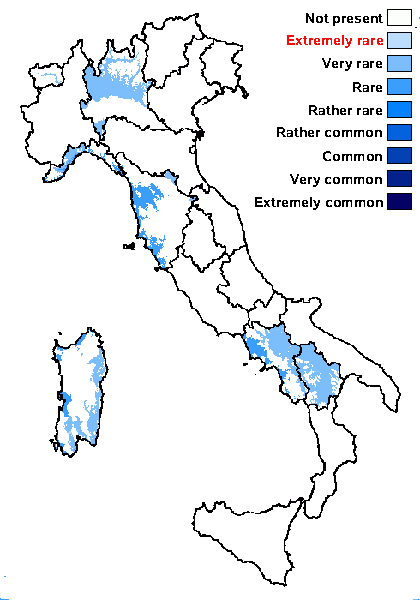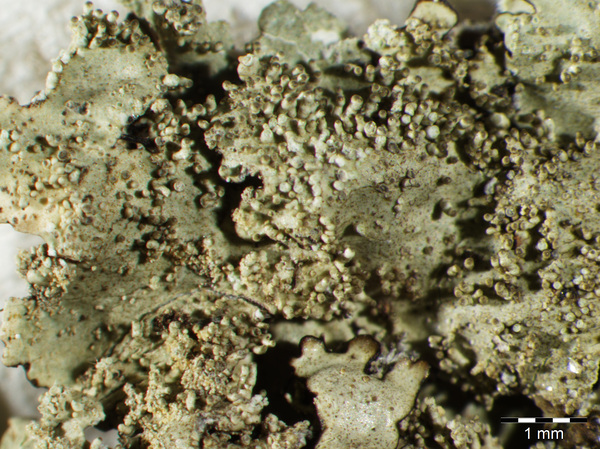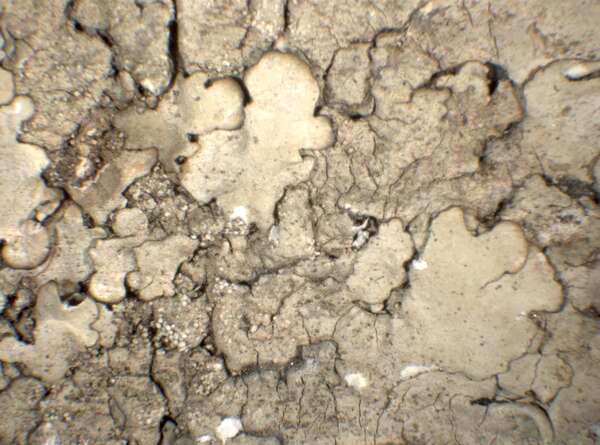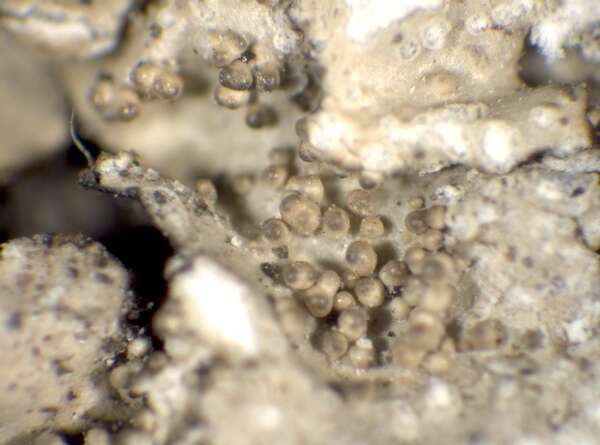Xanthoparmelia verrucigera (Nyl.) Hale
Smithsonian Contr. Bot., 74: 220, 1990. Basionym: Parmelia verrucigera Nyl. - Flora, 55: 426, 1872.
Synonyms: Parmelia conspersa var. isidiophora Trevis.; Parmelia conspersa var. lusitana (Nyl.) Lettau; Parmelia conspersa var. verrucigera (Nyl.) Boistel; Parmelia isidiigera f. ligustica Gyeln.; Parmelia lusitana Nyl.; Parmelia pseudoservitiana Gyeln.; Parmelia pulvinaris var. mediterranea Gyeln.; Parmelia servitiana Gyeln.; Parmelia tarpatakensis Gyeln.; Xanthoparmelia lusitana (Nyl.) Krog
Distribution: N - VG (Giordani & al. 2002b), Frl (Giordani & al. 2002b), Ven (Giordani & al. 2002b), Lomb (Favero-Longo & al. 2023), VA (Matteucci & al. 2015c), Lig (Giordani & al. 2002b, 2009). C - Tosc (Giordani & al. 2002b), Sar (Giordani & al. 2002b, Rizzi & al. 2011). S - Camp (Giordani & al. 2002b), Bas (Giordani & al. 2002b).
Description: Thallus foliose, heteromerous, dorsiventral, adnate to loosely adnate, forming up to 10 cm wide rosettes. Lobes elongate, flat to slightly convex, separate to weakly imbricate,1-3 mm wide, yellow-green, smooth, shiny, epruinose and emaculate, densely covered in cylindrical, mostly coralloid, branched isidia. Lower surface black, with simple to furcate, black rhizines. Upper cortex paraplectenchymatous, with a pored epicortex, the cell walls with Xanthoparmelia-type lichenan; medulla white. Apothecia rare, lecanorine, substipitate, 3-7 mm across, with a brown, epruinose disc, and an isidiate thalline margin. Epithecium brown; hymenium and hypothecium colourless. Asci 8-spored, thick-walled, the apex I+ blue with a wide, divergent axial body, Lecanora-type. Ascospores 1-celled, hyaline, ellipsoid, 6-10 x 4-6 µm. Pycnidia immersed, black. Photobiont chlorococcoid. Spot tests: cortex K-, C-, KC+ yellowish, P-, N+ blue-green; medulla K+ persistently yellow, C-, KC-, P+ orange, UV-. Chemistry: cortex with usnic acid (major); medulla with stictic, lusitanic and verrucigeric acids. Note: on siliceous rocks; related to X. conspersa, but chemically different (stictic and lusitanic acids, lacking norstictic acid).
Growth form: Foliose, broad lobed
Substrata: rocks
Photobiont: green algae other than Trentepohlia
Reproductive strategy: mainly asexual, by isidia, or isidia-like structures (e.g. schizidia)
Commonnes-rarity: (info)
Alpine belt: absent
Subalpine belt: absent
Oromediterranean belt: absent
Montane belt: absent
Submediterranean belt: very rare
Padanian area: absent
Humid submediterranean belt: absent
Humid mediterranean belt: rare
Dry mediterranean belt: absent

Predictive model
Herbarium samples

Harrie Sipman – Source http://www.bgbm.fu-berlin.de/sipman/Zschackia/AegeanLichens/CaloplacaAC.htm - As Caloplaca oasis


P.L. Nimis; Owner: Department of Life Sciences, University of Trieste
Herbarium: TSB (7653)
2002/02/13
Growth form: Foliose, broad lobed
Substrata: rocks
Photobiont: green algae other than Trentepohlia
Reproductive strategy: mainly asexual, by isidia, or isidia-like structures (e.g. schizidia)
Commonnes-rarity: (info)
Alpine belt: absent
Subalpine belt: absent
Oromediterranean belt: absent
Montane belt: absent
Submediterranean belt: very rare
Padanian area: absent
Humid submediterranean belt: absent
Humid mediterranean belt: rare
Dry mediterranean belt: absent

Predictive model
| Herbarium samples |

Harrie Sipman – Source http://www.bgbm.fu-berlin.de/sipman/Zschackia/AegeanLichens/CaloplacaAC.htm - As Caloplaca oasis


 Index Fungorum
Index Fungorum
 GBIF
GBIF




